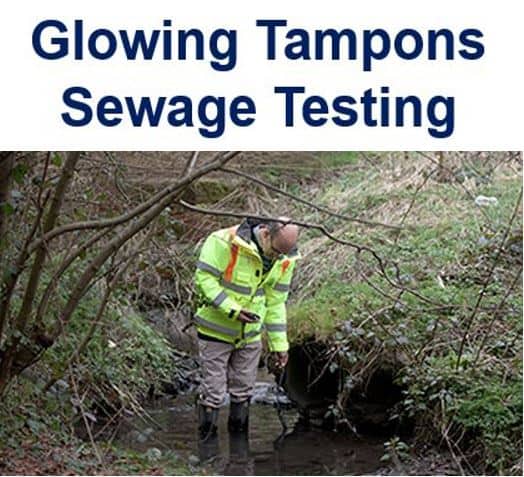Tampons that glow in the dark under ultra-violet light have been used by University of Sheffield engineers to help them identify where waste water from showers, sinks, washing machines and baths is polluting streams and rivers, and to pinpoint where the problem originated in each case.
The natural, untreated cotton within tampons absorbs chemicals commonly used in laundry detergents, shampoos and toilet paper. These chemicals (optical brighteners) are used to make white whiter and colours brighter, and show up under UV (ultra-violet) light, like some glowing t-shirts do in certain clubs and bars.
Researchers from the Faculty of Engineering at the University of Sheffield showed that when tampons are suspended in water containing even small traces of sewage or detergents, they will pick up optical brighteners and glow when UV light is directed at them.

Professor David Lerner carrying out pollution tests. (Image: University of Sheffield)
They published their findings in the Water and Environment Journal (citation below).
Pollution may exist in many forms. Light, construction debris, household/business waste, airborne particulates, and chemicals, for example, are possible pollutants.
Glowing tampons may help track down over 1m homes
Study leader, Professor David Lerner, explained:
“More than a million homes have their waste water incorrectly connected into the surface water network, which means their sewage is being discharged into a river, rather than going to a treatment plant. Unfortunately, it’s very difficult to detect where this is happening, as the discharge is intermittent, can’t always be seen with the naked eye and existing tests are complex and expensive.”
“The main difficulty with detecting sewage pollution by searching for optical brighteners is finding cotton that does not already contain these chemicals. That’s why tampons, being explicitly untreated, provide such a neat solution. Our new method may be unconventional – but it’s cheap and it works.”
The scientists carried out laboratory trials to find out how much detergent would be required in the water before the tampons started glowing.
They found that the optical brighteners absorbed by the tampons showed up in a solution containing 0.01 ml of detergent per litre of water – this is 300 times more dilute than one would expect in a surface water pipe.
The tampons, which had been dipped in the solution for just five seconds, continued glowing under UV light for thirty days.
Field trial
Prof. Lerner and colleagues then carried out a field trial. They suspended tampons for three days in sixteen different surface water outlets that ran into streams and rivers in Sheffield and then tested the tampons under UV light.
In nine surface water outlets the tampons glowed – showing there was sewage pollution.
The researchers, with help from Yorkshire Water, tried to find exactly where the sewage was entering the system. They followed the pipe network back from four of the nine polluted outlets, dipping a tampon in at each manhole.
They succeeded in isolating the sections of each network where the sewage originated, identifying the households that would need to be inspected in more detail.
In one area, a visual inspection immediately revealed a house where both a soil stack and sink were connected to the wrong sewer.
Glowing tampons easier than dye test
Prof. Lerner said:
“Often the only way to be sure a house is misconnected is through a dye test – putting dye down a sink or toilet and seeing where the coloured water appears in the sewer.”
“It’s clearly impractical for water companies to do this for all the households they supply, but by working back from where pollution is identified and narrowing it down to a particular section of the network, the final step of identifying the source then becomes feasible.”
Domestic water pollutants change the invertebrate and bacterial life in rivers, encouraging pollutant-tolerant species to thrive, which leads to the build-up of ‘sewage fungus’. Sewage fungus is visible as a grey lining to the river bed. Waste water discharges may also bring pathogens such as norovirus to rivers and streams.
Most household that are wrongly connected have no idea they are discharging their waste water into the wrong system. When the problem is identified it is rectified immediately.
In the UK, local authorities have the power to complete the work and charge the householder. However, this power is very rarely used.
Now that this study has proved the glowing-tampon method works in practice in the field, Prof. Lerner hopes to carry out a trial on a much larger scale to identity all sources of sewage pollution on the Bradford Beck, the river that runs through Bradford.
The research was funded by the EPSCR (Engineering and Physical Sciences Research Council).
Citation: “A low cost method to detect polluted surface water outfalls and misconnected drainage,” Dave Mark Chandler andDavid Nicholas Lerner. Water and Environment Journal. Published 31 March, 2015. DOI: 10.1111/wej.12112.

